Experimental Investigations on the Effect of Axial Homogenous Magnetic Fields on Propagating Vortex Flow in the Taylor–Couette System
Abstract
1. Introduction
2. Materials and Methods
2.1. Experimental Design and Flow Detection
2.2. Characterization of the Used Fluids
3. Results and Discussion
3.1. General Discussion of the Investigated pV State
3.2. Influence of Axial Magnetic Fields
3.2.1. General Aspects
3.2.2. Influence on the Spatial and Temporal Behavior
4. Conclusions
- A strong stepwise applied magnetic field disturbed the pV state in such a manner that the flow was temporarily superimposed by SPIs.
- The orbital frequency increased by 40% with increasing field strengths up to 20 kA/m when the field strength was applied and increased gradually. Furthermore, the vortex propagation velocity increased with increasing field strengths.
- At field strengths of above 20 kA/m, the data basis during the conducted measuring campaigns was not reliable due to insufficient SNR. However, some of the made observations indicate that major changes in the temporal and the spatial behavior of the pV state may occur at higher field strength regimes. Without claiming to make generally valid statements, the change in the wavenumber k and the strong decrease in the orbital frequency fO to app. 40% of the initial value should be mentioned as examples.
Supplementary Materials
Author Contributions
Funding
Conflicts of Interest
References
- Taylor, G.I. Stability of a Viscous Liquid Contained between Two Rotating Cylinders. Philos. Trans. R. Soc. Lond. A Math. Phys. Eng. Sci. 1923, 223, 289–343. [Google Scholar] [CrossRef]
- Donnelly, R.J. Taylor-Couette Flow: The Early Days. Phys. Today 1991, 44, 32–39. [Google Scholar] [CrossRef]
- Andereck, C.D.; Liu, S.S.; Swinney, H. Flow regimes in a circular Couette system with independently rotating cylinders. J. Fluid Mech. 1986, 164, 155–183. [Google Scholar] [CrossRef]
- Coles, D. Transition in circular Couette flow. J. Fluid Mech. 1965, 21, 385–425. [Google Scholar] [CrossRef]
- Donnelly, R.J.; Fultz, D.; Chandrasekhar, S. Experiments on the stability of viscous flow between rotating cylinders II. Visual observations. Proc. R. Soc. Lond. Ser. A-Math. Phys. Eng. Sci. 1960, 258, 101–123. [Google Scholar]
- Grossmann, S.; Lohse, D.; Chao, S. High–Reynolds Number Taylor-Couette Turbulence. Annu. Rev. Fluid Mech. 2016, 45, 53–80. [Google Scholar] [CrossRef]
- Stuart, J.T. Taylor-Vortex Flow: A dynamical system. SIAM Rev. 1986, 28, 315–342. [Google Scholar] [CrossRef]
- Altmeyer, S.; Hoffmann, C.; Heise, M.; Abshagen, J.; Pinter, A.; Lücke, M.; Pfister, G. End wall effects on the transitions between Taylor vortices and spiral vortices. Phys. Rev. E 2010, 81. [Google Scholar] [CrossRef]
- Mullin, T.; Blohm, C. Bifurcation phenomena in a Taylor-Couette flow with asymmetric boundary conditions. Phys. Fluids 2001, 13, 136–140. [Google Scholar] [CrossRef]
- Schulz, A. Verzweigungen und Strukturen in der Strömung Zwischen Unabhängig Rotierenden Zylindern. Ph.D. Thesis, Christian Albrechts Universität, Kiel, Germany, 2006. [Google Scholar]
- Langenberg, J.; Pfister, G.; Abshagen, J. The effect of physical boundaries on oscillatory bifurcation in counterrotating Taylor-Couette flow. Phys. Fluids 2004, 16, 2757–2762. [Google Scholar] [CrossRef]
- Edwards, W.S.; Beane, S.R.; Varma, S. Onset of wavy vorticies in the finite length Couette-Taylor problem. Phys. Fluids A Fluid Dyn. 1991, 3, 1510–1518. [Google Scholar] [CrossRef]
- Langenberg, J.; Heise, M.; Pfister, G.; Abshagen, J. Convective and absolute instabilities in counter-rotating spiral Poiseuille flow. Theor. Comput. Fluid Dyn. 2004, 18, 97–103. [Google Scholar] [CrossRef]
- Crespo del Arco, E.; Bontoux, P.; Launder, B.E. Stability, transition and turbulence in rotating cavities. Wit. Trans. Sci. Eng. 2005, 6, 141–195. [Google Scholar]
- Czarny, O.; Serre, E.; Bontoux, E. Interaction between Ekman pumping and the centrifugal instability in Taylor-Couette flow. Phys. Fluids 2003, 15, 467–477. [Google Scholar] [CrossRef]
- Benjamin, T.B.; Mullin, T. Anomalous modes in the Taylor experiment. Proc. R. Soc. Lond. Ser. A-Math. Phys. Eng. Sci. 1981, 377, 221–249. [Google Scholar] [CrossRef]
- Ahlers, G.; Cannell, D.S.; Dominguez-Lerma, M.A.; Heinrichs, R. Wavenumber selection and eckhaus instability in couette-taylor flow. Physics D 1986, 23, 202–219. [Google Scholar] [CrossRef]
- Hoffmann, C. Struktur, Dynamik und Bifurkationsverhalten von Spiralwirbeln im Taylor-Couette System Mit und Ohne Durchfluss. Ph.D. Thesis, Universität des Saarlandes, Saarbrücken, Germany, 2005. [Google Scholar]
- Benjamin, T.B. Bifurcation Phenomena in Steady Flows of a Viscous Fluid II: Experiments. Proc. R. Soc. Lond. Ser. A-Math. Phys. Eng. Sci. 1978, 359, 27–43. [Google Scholar] [CrossRef]
- Hoffmann, C.; Altmeyer, S.; Heise, M.; Abshagen, J.; Pfister, G. Axissymmetric propagating vortices in centrifugally stable Taylor-Couette flow. J. Fluid Mech. 2013, 728, 470. [Google Scholar] [CrossRef]
- Abshagen, J.; Heise, M.; Langenberg, J.; Pfister, G. Imperfect Hopf bifurcation in spiral Poiseuille flow. Phys. Rev. E 2007, 75. [Google Scholar] [CrossRef]
- Riecke, H.; Papp, H. Perfect wave number selection and drifting patterns in ramped Taylor vortex flow. Phys. Rev. Lett. 1987, 59, 2570–2573. [Google Scholar] [CrossRef]
- Ambacher, O.; Odenbach, S.; Stierstadt, K. Rotational viscosity in ferrofluids. Z. Phys. B 1992, 86, 29–32. [Google Scholar] [CrossRef]
- Holderied, M. Rotational viscosity of ferrofluids and the Taylor instability in magnetic field. Z. Phys. B 1988, 70, 431–433. [Google Scholar] [CrossRef]
- McTague, J.P. Magnetoviscosity of Magnetic Colloids. J. Chem. Phys. 1969, 51, 133–136. [Google Scholar] [CrossRef]
- Rosensweig, R.E. Ferrohydrodynamics; Cambridge University Press: Cambridge, UK, 1985. [Google Scholar]
- Shliomis, M.I. Effective Viscosity of Magnetic Suspensions. Sov. Phys. JETP 1972, 34, 1291–1294. [Google Scholar]
- Odenbach, S.; Thurm, S. Magnetoviscous Effects in Ferrofluids. In Ferrofluids—Magnetically Controllable Fluids and their Applications, 1st ed.; Lecture Notes in Physics; Odenbach, S., Ed.; Springer: Berlin, Germany, 2002; Volume 71, pp. 185–201. [Google Scholar]
- Altmeyer, S.; Hoffmann, C.; Leschhorn, A.; Lücke, M. Influence of homogeneous magnetic fields on the flow of a ferrofluid in the Taylor Couette system. Phys. Rev. E 2010, 82, 016321. [Google Scholar] [CrossRef]
- Leschhorn, A.; Lücke, M. Magnetization of Rotating Ferrofluids: Predictions of Different Theoretical Models. Z. Phys. Chem. 2006, 220, 219–224. [Google Scholar] [CrossRef]
- Leschhorn, A.; Lücke, M.; Hoffmann, C.; Altmeyer, S. Stability of the circular Couette flow of a ferrofluid in an axial magnetic field: Influence of polydispersity. Phys. Rev. E 2009, 79, 0363308. [Google Scholar] [CrossRef]
- Niklas, M. Influence of magnetic fields on Taylor vortex formation in magnetic fluids. Z. Phys. B 1987, 68, 493–501. [Google Scholar] [CrossRef][Green Version]
- Odenbach, S.; Gilly, H. Taylor vortex flow of magnetic fluids under the influence of an azimuthal magnetic field. J. Magn. Magn. Mater. 1996, 152, 123–128. [Google Scholar] [CrossRef]
- Reindl, M.; Leschhorn, A.; Lücke, M.; Odenbach, S. Experimental and theoretical investigations on Taylor–Couette flow of ferrofluids subject to magnetic fields. Phys. Procedia 2010, 9, 121–125. [Google Scholar] [CrossRef][Green Version]
- Reindl, M.; Odenbach, S. Effect of axial and transverse magnetic fields on the flow behavior of ferrofluids featuring different levels of interparticle interaction. Phys. Fluid 2011, 23, 093102. [Google Scholar] [CrossRef]
- Reindl, M.; Odenbach, S. Influence of a homogeneous axial magnetic field on Taylor-Couette flow of ferrofluids with low particle–particle interaction. Exp. Fluids 2011, 50, 375–384. [Google Scholar] [CrossRef]
- Reindl, M. Kontrolle von Strömungen in magnetischen Kolloiden. Ph.D. Thesis, Technische Universtität Dresden, Dresden, Germany, 2011. [Google Scholar]
- Vislovic, A.N. Influence of a magnetic field on the Taylor instability in magnetic fluids. J. Appl. Mech. Tech. Phys. 1986, 27, 72–78. [Google Scholar] [CrossRef]
- Fanselau, G. Die Erzeugung weitgehend homogener Magnetfelder durch Kreisströme. Z. Phys. 1929, 54, 260–269. [Google Scholar] [CrossRef]
- Borin, D.; Odenbach, S. Magnetic measurements on frozen ferrofluids as a method for estimating the magnetoviscous effect. J. Phys. Condens. Matter 2009, 21, 246002. [Google Scholar] [CrossRef] [PubMed]
- Odenbach, S.; Rylewicz, T.; Heyen, M. A rheometer dedicated for the investigation of viscoelastic effects in commercial magnetic fluids. J. Magn. Magn. Mater. 1999, 201, 155–158. [Google Scholar] [CrossRef]
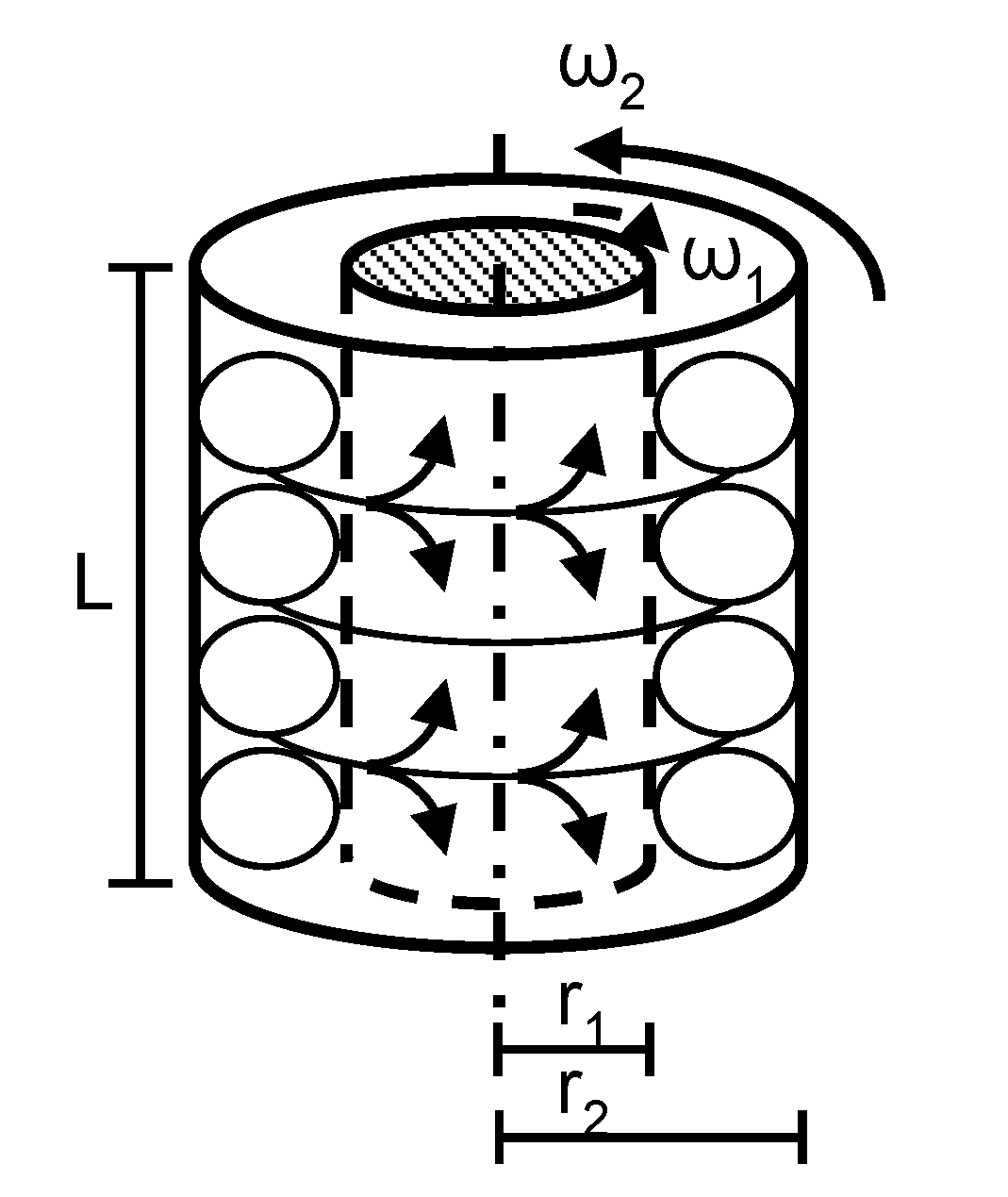
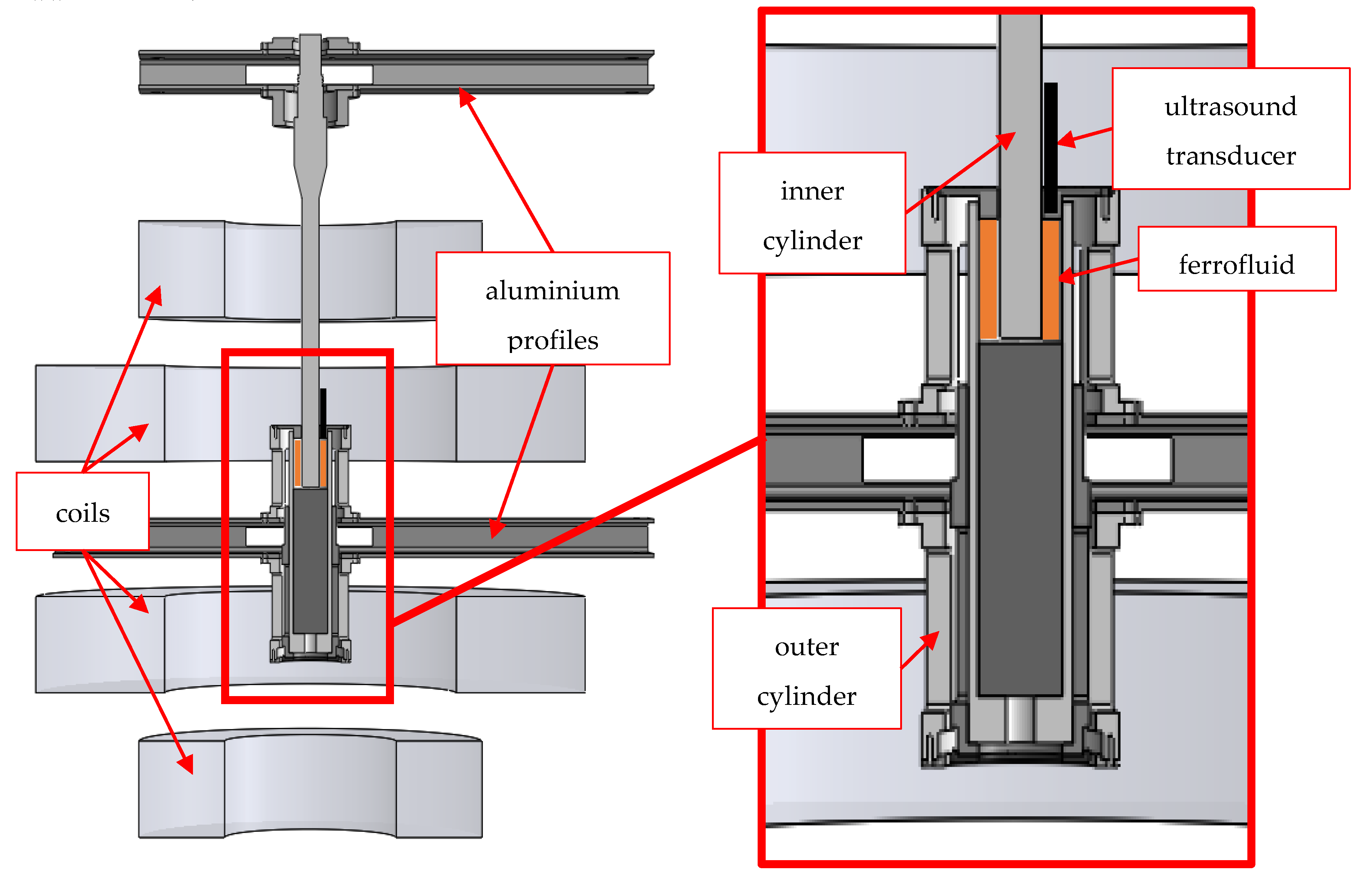
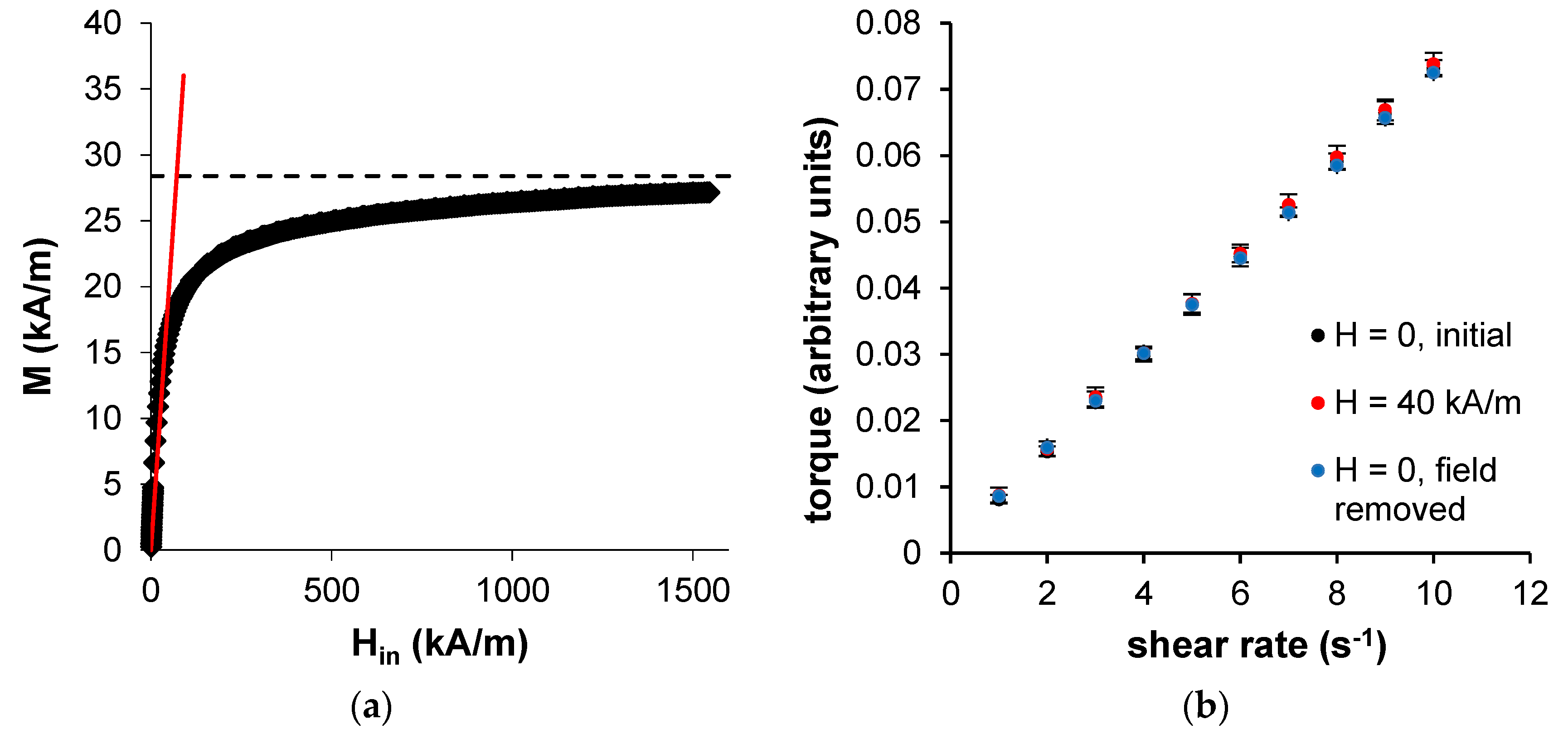
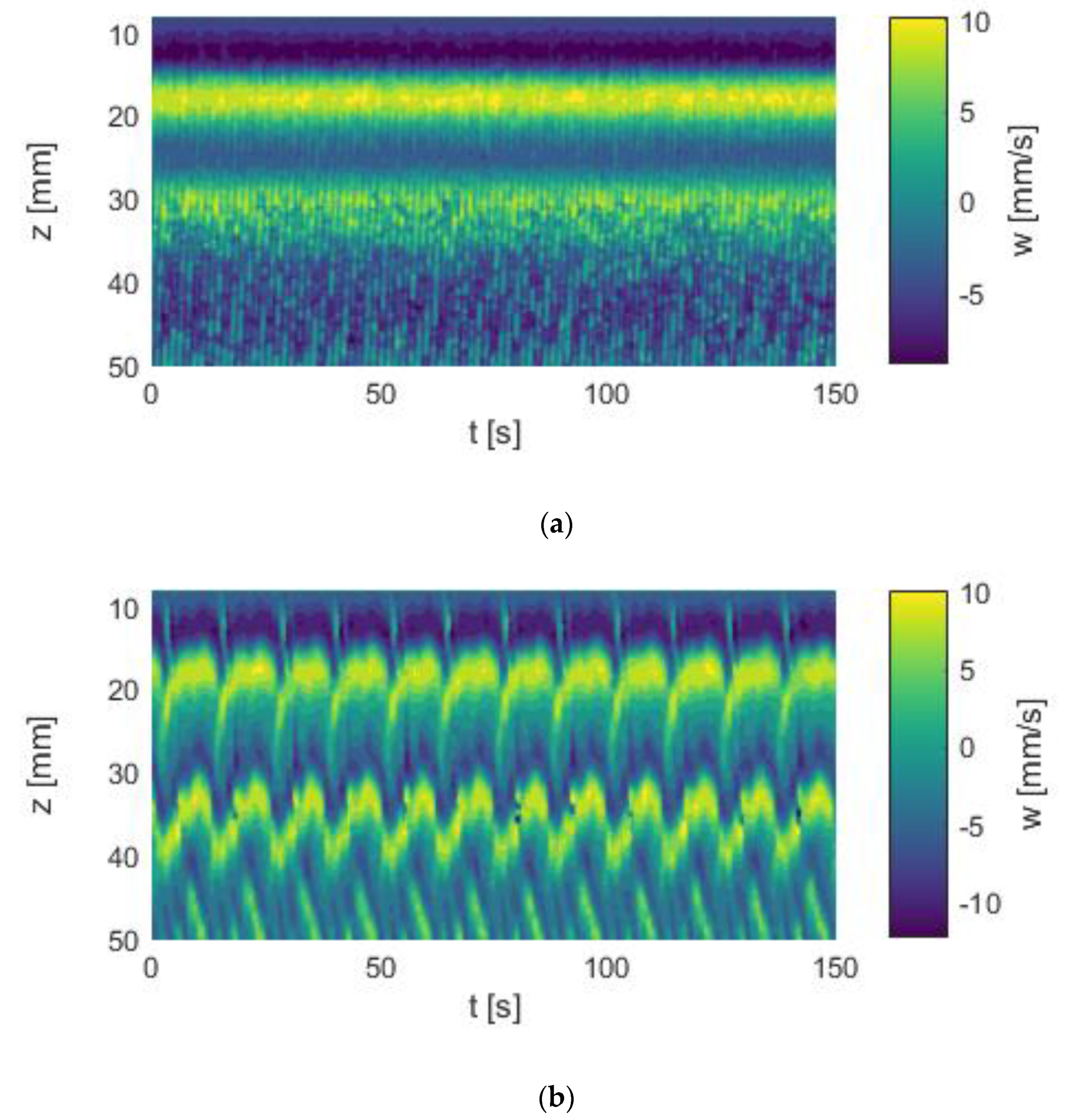

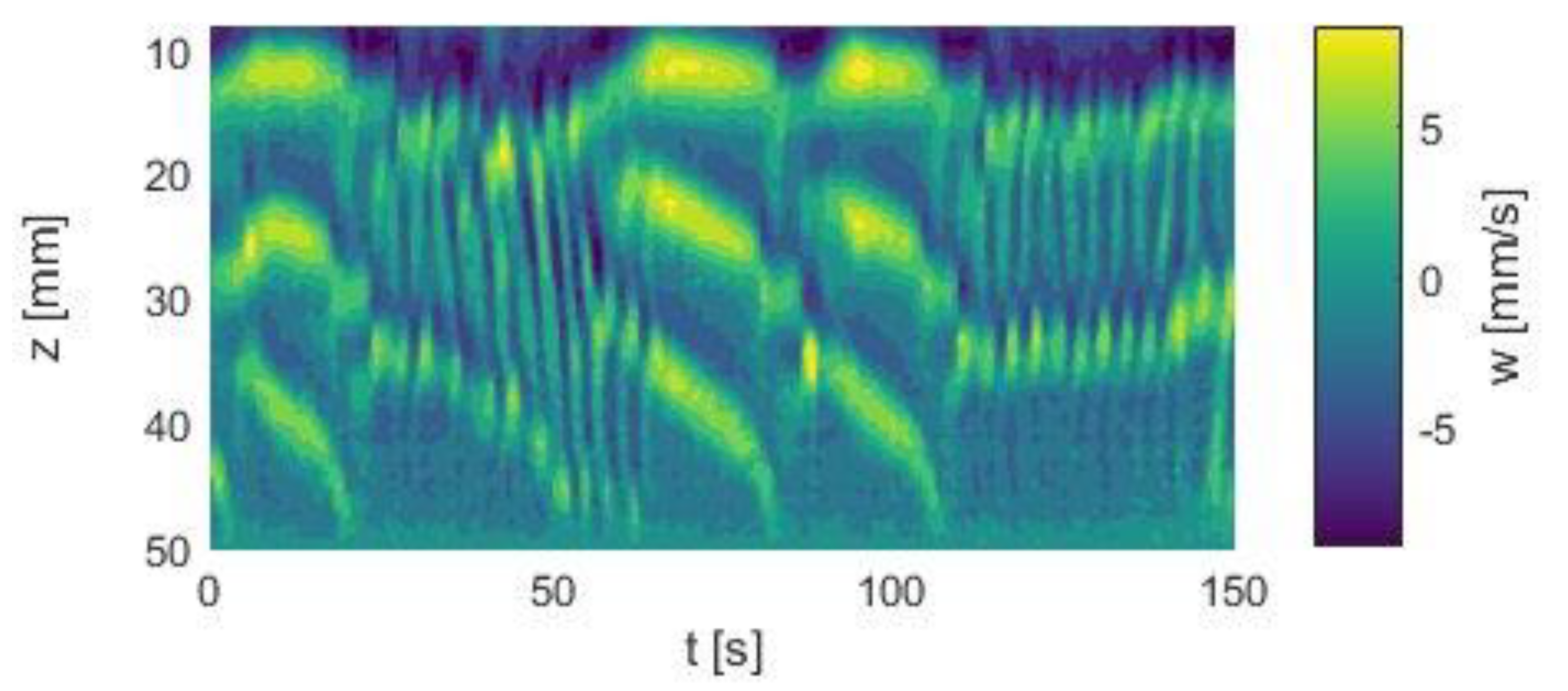
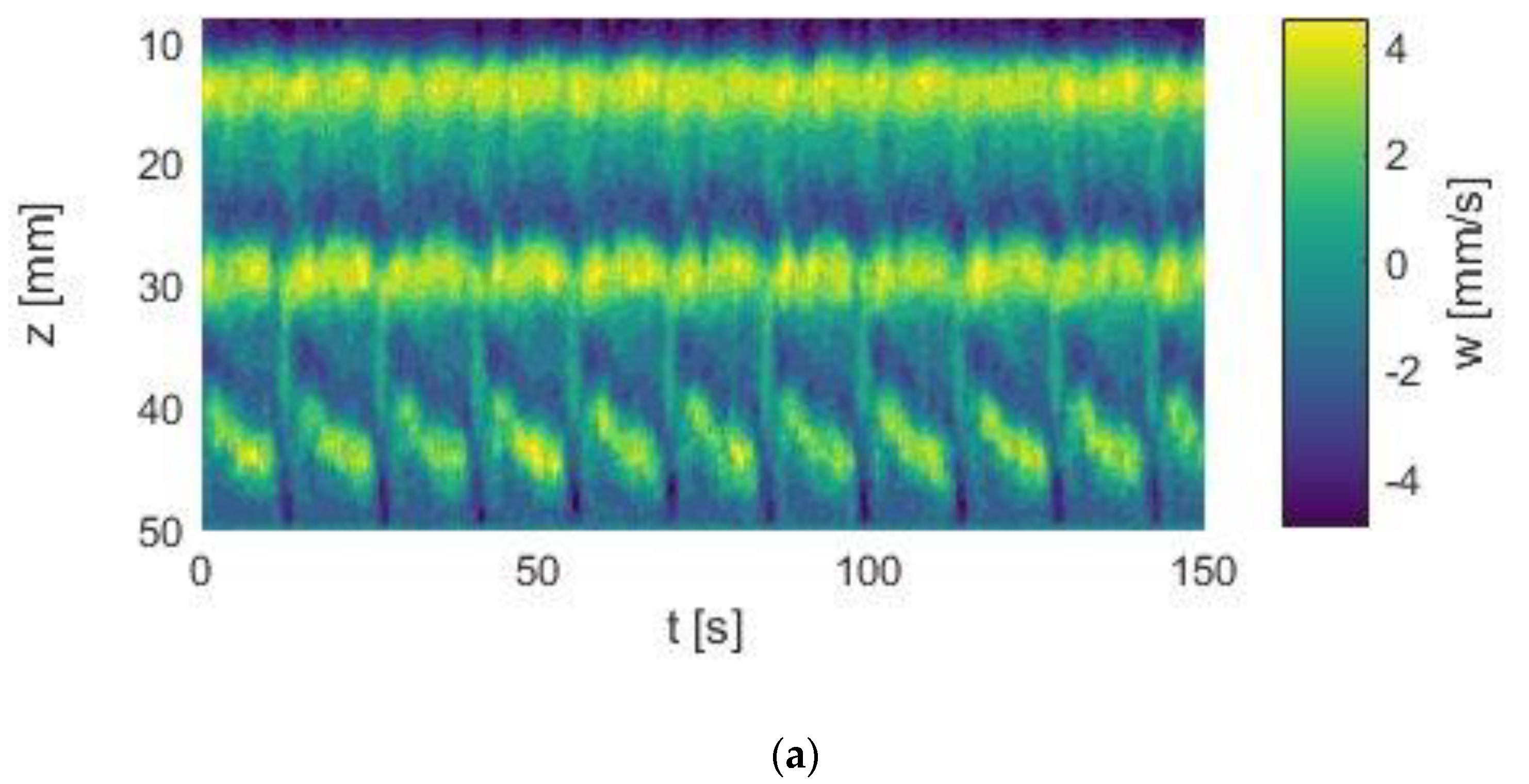
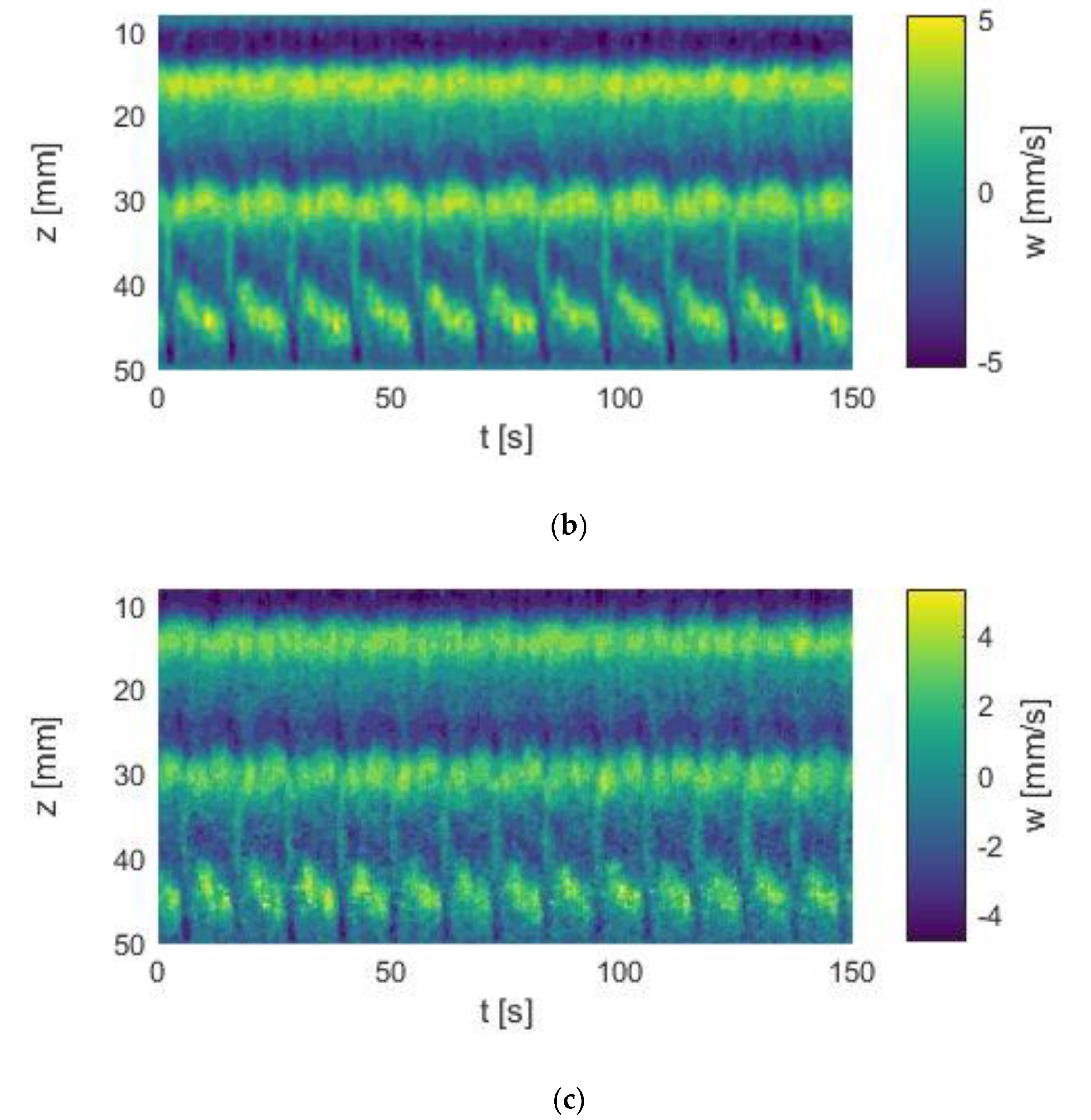

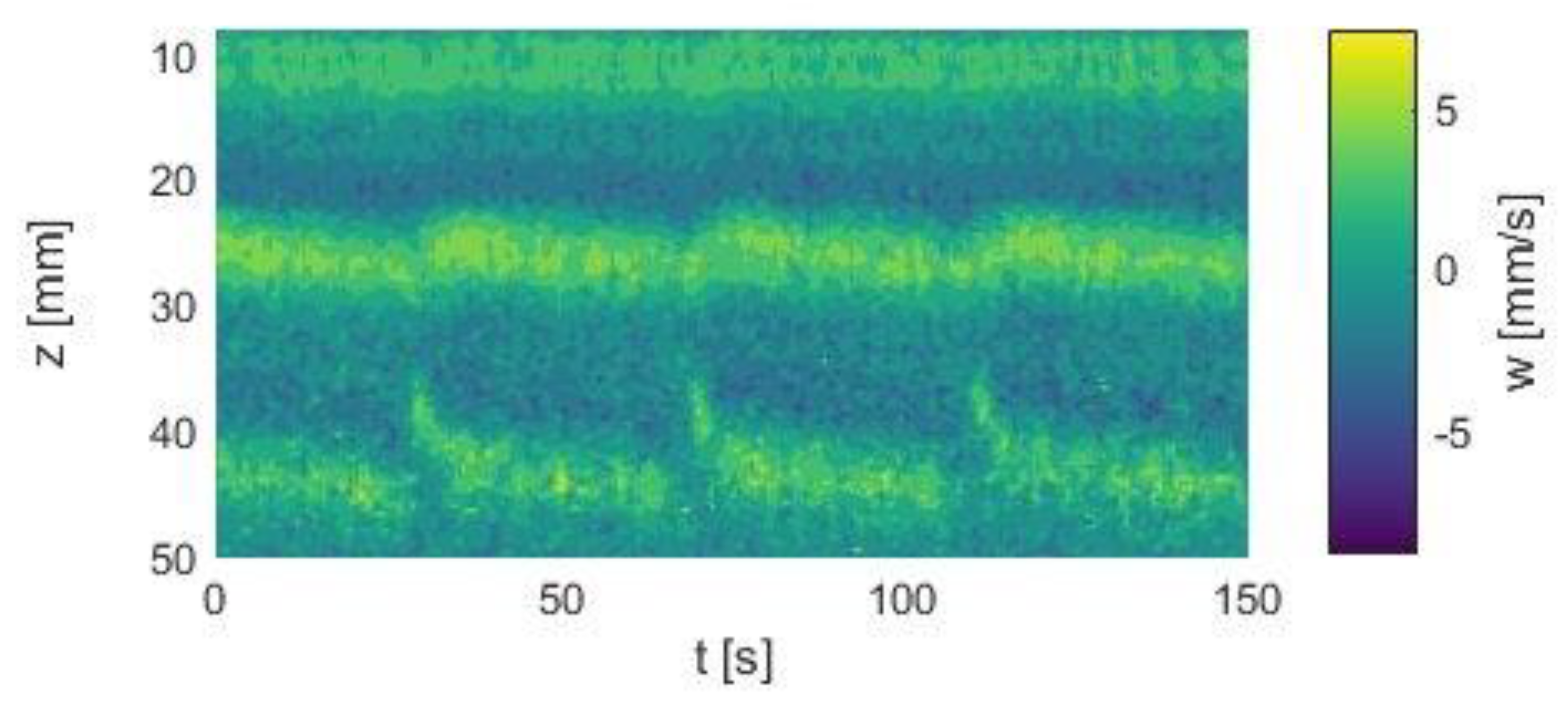
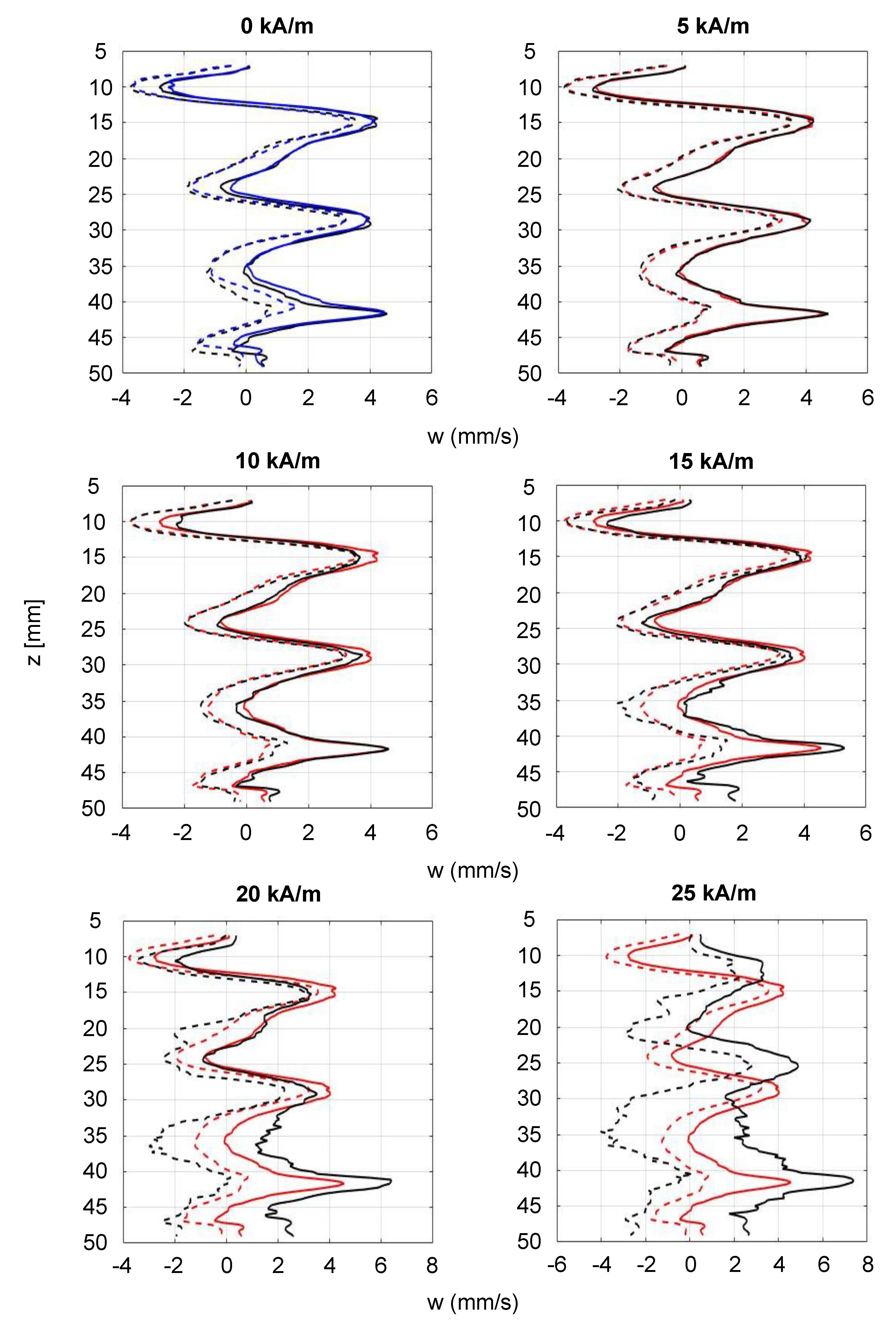
| Property | Value | Unit |
|---|---|---|
| Magnetic material | Magnetite | - |
| Volumetric concentration (Φ) | 0.063 | - |
| Saturation magnetization (MS) | 28.4 | kA/m |
| Initial susceptibility (χin) | 0.75 | - |
| Kinematic viscosity (ν) | (5.02 ± 0.18) × 10−6 | m2/s |
© 2019 by the authors. Licensee MDPI, Basel, Switzerland. This article is an open access article distributed under the terms and conditions of the Creative Commons Attribution (CC BY) license (http://creativecommons.org/licenses/by/4.0/).
Share and Cite
Ilzig, T.; Stöckel, K.; Odenbach, S. Experimental Investigations on the Effect of Axial Homogenous Magnetic Fields on Propagating Vortex Flow in the Taylor–Couette System. Materials 2019, 12, 4027. https://doi.org/10.3390/ma12244027
Ilzig T, Stöckel K, Odenbach S. Experimental Investigations on the Effect of Axial Homogenous Magnetic Fields on Propagating Vortex Flow in the Taylor–Couette System. Materials. 2019; 12(24):4027. https://doi.org/10.3390/ma12244027
Chicago/Turabian StyleIlzig, Thomas, Katharina Stöckel, and Stefan Odenbach. 2019. "Experimental Investigations on the Effect of Axial Homogenous Magnetic Fields on Propagating Vortex Flow in the Taylor–Couette System" Materials 12, no. 24: 4027. https://doi.org/10.3390/ma12244027
APA StyleIlzig, T., Stöckel, K., & Odenbach, S. (2019). Experimental Investigations on the Effect of Axial Homogenous Magnetic Fields on Propagating Vortex Flow in the Taylor–Couette System. Materials, 12(24), 4027. https://doi.org/10.3390/ma12244027






